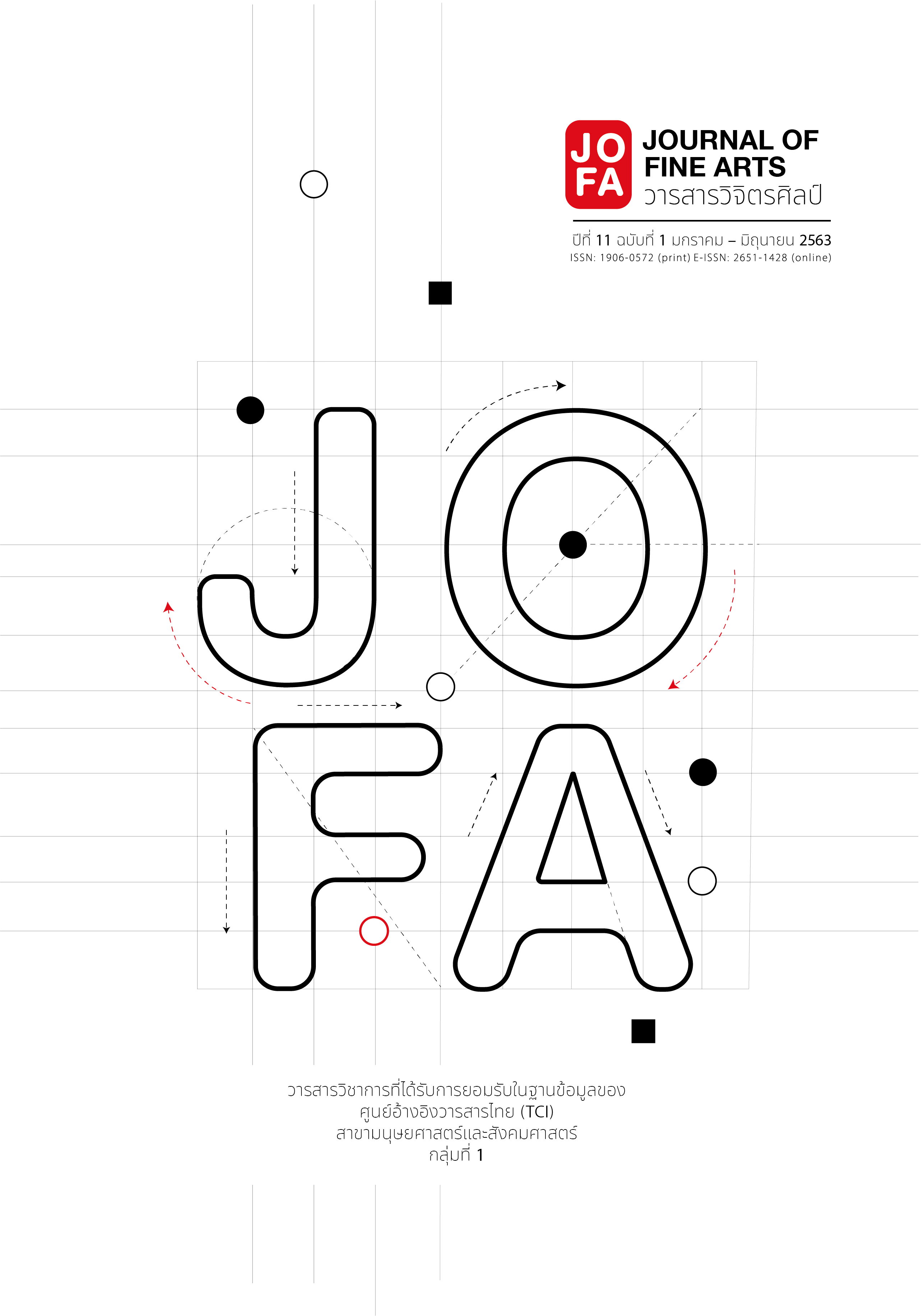The Study on Art Heritage in Wiang Lo Ancient City: Artistic Styles and Presumption on the Patterns of the Ruins.
Main Article Content
Abstract
The objectives of this research project are (1) to study on the patterns of art from historical documents and archaeological information in order to build up body of knowledge of art history; and (2) the findings from the study will lead to the presumed designs of the
reconstructed ruins. The findings are as follows.
1. There are 16 monastery ruins that had the plan consisting of Phutthawat (public area) that laid in the east - west alignment, with the Vihara (main chapels/pantheons) and principle
pagodas facing the east mainly. They are most found in Wiang Lo Ancient City. The key examples that have had the 3D images of presumed reconstruction are Phra Kaeo Temple and Si Chum Temple.
2. The key patterns of Vihara that have had 3D images of presumed reconstruction can be divided in 4 groups, namely, 1) Vihara with 1 section of Yok Ket (the decoration parts extended from walls with stepped extended corners); 2) Vihara with rectangular plan; 3) pantheons; and 4) Vihara with special characteristics, compared with the technique of the construction of
Vihara in Lanna Style (Mok Vihara). As for the pagodas, the unique characteristics that are
interesting are supposed to be the common features of pagodas in the area of Ing River Basin. An example of the pagoda with 3D image of presumed reconstruction is Lom That Pagoda.
3. Art works in Wiang Lo Ancient City show the network and relationship between ancient cities in Ing River Basin and civilizations in the areas of Upper Mekong River Basin such as Chiang Saen and Luang Phrabang, as well as civilizations in Lanna and Sukhothai Kingdoms. In addition, these findings also concur with archaeological information and information from inscriptions that points out the significance of Lo City from 21st Buddhist Century to 24th Buddhist Century as well.
Article Details
References
Boonyasurat, W. Chư̄nchom Sathāpat Wat Nai Lūang Phra Bāng [Luang Phra Bang’s Temple Architecture appreciation]. 2nd edition. Bangkok: Muang Boran, 2005.
________. Wihān lānnā [Lanna Vihara]. Bangkok: Muang Boran, 2001.
________. “Rāi-ngān kānwičhai rư̄ang kānsưksā rūpbǣp wihān song prāsāt nai khēt phāk nư̄a ʻamphœ̄ Chīang Mai [The study of Vihara Prasat style in Chiang Mai district,Chiang Mai].” Research report, Department of Thai Arts, Faculty of Fine Arts, Chiang Mai University, 1991.
Chaidarun, K. Čhārưk thī khon phop mai nai Mư̄ang Phayao [The new inscriptions from Phayao]. Phayao: Nakhō̜nnio kānphim, 2009.
Cher green Limited Partnership. Rāingān kān khut tǣng bōrānnasathān bān rō̜ng hai mū nưng læ sip ʻet tambon mǣ sai ʻamphœ̄ mư̄ang čhangwat Phayao [Archaeology digging out the ancient remains at Ban Rong Hai, Mae Sai, Mueang Phayao]. Phayao: n.p., 2003.
________. Khrōngkān čhattham phǣn mǣbot ʻanurak læ phatthanā mư̄ang bōrān wīang-lō̜ ʻongkān bō̜rihānsūantambonlō̜ ʻamphœ̄ čhun čhangwat Phayao [Master plan for conservation and development of wiang lo ancient town, lo subdistrict administration organization]. (Unpublished manuscript). 2007.
Chīwasan, S. et al. Sathāpattayakam Phayao læ Nān [Phayao and Nan Architechture]. Chiang Mai: Social Research Institute, Chiang Mai University, 1988.
Dētwongyā, J. Prawattisāt Læ Sinlapakam wīang kum kām [History and Arts of Wiang Kum Kam]. Chiang Mai: Mūnnithisathābanphatthanāmư̄ang, 2005.
________. Phra čhēdī mư̄ang chīang sǣn. Bangkok: O.S. Printing House, 1996.
Fine Arts office 7, Nan Province. Khrōngkān ʻanurak læ phatthanā mư̄ang bōrān wīang-lō̜ Phō̜.Sō̜. sō̜ngphanhārō̜isīsipčhet - sō̜ngphanhārō̜isīsippǣt [ Project of conservation and development of wing lo ancient town]. (Unpublished manuscript of the excavation and conservation of 16 historic sites report).
Manikheat, N. Interview by Chankhanit Arvorn, Faculty of Industrial Technology, Chiang Rai Rajabhat University, June 15, 2017.
Ongsakul, S. Prawattisāt lānnā [The History of the Lanna Kingdom], 7th edition. Nonthaburi: Amarin, 2010.
Phraichayačhit, S. “Kān khutkhon sưksā čhēdī phra thāt nō̜ng hā wat pā mai? thī wīang lō̜ ʻamphœ̄ čhun čhangwat Phayao [The excavations of Nong Ha Pagoda, Wat Pa Mai? at Wiang Lo, Chun District, Phayao].” in Bōrānnakhadī lānnā [Archeology of Lanna], Edited by Sayan Phraichayačhit, Bangkok: Samaphan Publishing.
Saisingha, S. Čhēdī phraphuttharūp hūptǣm sim sinlapa lāo læ ʻĪsān [Pagoda, a Statue of
Buddha, Mural painting, Sim, Laos and Thai Northeast Arts]. Bangkok: Museum Press, 2012.
________. “Phrathāt Hariphunchai: tonbǣp čhēdī song rakhang bǣp lānnā [Phra That Hariphunchai: Lanna bell-shaped pagado model].” Damrong Journal 3, Vol. 6 (July - December 2004): 60-61.
________. “Rāingān kānwičhai rư̄ang sinlapa mư̄ang chīang sǣn: wikhro̜ ngān sinlapakam rūam kap lakthān thāng bōrānnakhadī læ ʻēkkasān thāng prawattisāt [Research report Art of Chiang Saen: Arts, Archaeological evidence and Historical document].” Research report, Division of Art History, Faculty of Archeology, Silpakorn University, 2007.
Sanyakiatikun, S. Sinlapa chīang tung [Kengtung Art]. Chiang Mai: Charoen Print Express, 2017.
Sīsōphāk, W. “Chumchon bōrān thī mī khū - khan din lō̜m rō̜p nai khēt lumnam ʻIng: Kānsưksā chœ̄ng phūmisāt kān tang thinthān læ khwāmsamphan nai rabop khrōngsāng sangkhom mư̄ang [Ancient fortfied communities in Mae Ing basin: study in settlement geography and urban society organization].” Master of Arts Thesis, Faculty of Archeology, Silpakorn University, 1995.
Srisuwan, C. “Rāingān Kānwičhai rư̄ang sathāpattayakam nai phư̄nthī prawattisāt wīang kum kām: kō̜ranī sưksā wat kān thōm. [The architecture in Wiang Kum Kam historical area: case study of Wat Kan Thom]”Research report, Faculty of Architect, Chiang Mai University, 2002.
Thamtong, T. “Mō̜k wihān: withī kamnot rabīap satsūan nai kānʻō̜kbǣp wihān nai phāk nư̄a khō̜ng Thai [Mok Vihara: Guidelines for Vihara Propotion and Design in Northern Thailand]” NAJUA: History of Architecture and Thai Architecture, Vol. 32 (January - December 2017): A52-A66.
________. Interview by Chankhanit Arvorn, Tourism Management, Faculty of Management Science, Lampang Rajabhat University, June 15, 2017.
Walliphodom, S. Prawattisāt bōrānnakhadī khō̜ng lānnā prathēt [Lanna Archaeological History]. Bangkok: Matichon, 2002.
Wichienkeeo, A. “Wīang lō̜: sưksā čhāk kānsamrūat tamnān læ čhārưk” [Wiang Lo: Study from exploring, Chronicle, and Ancient inscriptions]. In Rūam botkhwām wichākān: lānnā khādī [Academic Journal collection: Lan Na Studies]. Chiang Mai: Faculty of Humanities and Social Sciences, Chiang Mai Rajabhat University, 1999. 170-174.


